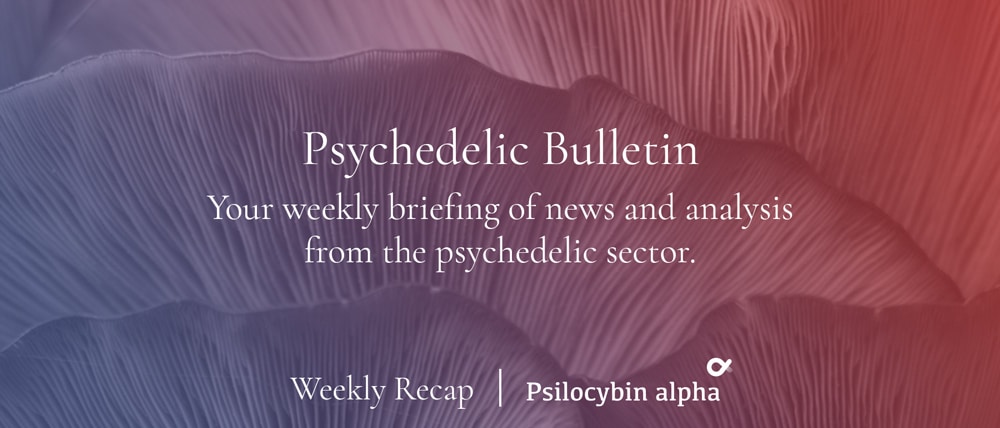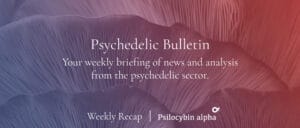This week has been somewhat quiet on the company news front, but a microdosing study published last Thursday has caused quite a stir. We dig deeper into the study below.
We’re also pleased to feature an op-ed from Robert A. Villa on the ecological and cultural damage left in the wake of an increasingly-popular pursuit of toad-derived 5-MeO-DMT.
And, of course, many other odds and ends await…
We’re Attending Horizons: Perspectives on Psychedelics
Next week, Horizons is hosting its 14th annual conference in New York City.
Our founder and editor Josh Hardman, editor-at-large Graham Pechenik, and Pharmaceutical Advisor Michael Haichin will be attending the conference and look forward to meeting those of you that are making the trip.
Learn more about the conference, and purchase last-minute tickets, on Horizons’ website.
Psychedelic Sector News
Microdosing: Little Doses, Little Evidence?
A study published last Thursday in Scientific Reports* has caused quite a stir among microdosing advocates and skeptics alike.
The publication, titled Adults who microdose psychedelics report health related motivations and lower levels of anxiety and depression compared to non-microdosers, was co-authored by a mix of researchers at the University of British Columbia and those with other affiliations, including mycologist and microdosing advocate Paul Stamets.
The study recruited participants by placing adverts and notices in media related to psychedelics, such as podcasts and virtual psychedelic research conferences. Quantified Citizen, a company that provides a platform that aims to “disrupt and democratize health research”, developed an iPhone app that solicited questionnaire responses and assessments from participants.
Ultimately, the study involved 8,703 self-recruited participants. 4,050 claimed to be microdosers, while 4,653 were non-microdosers. Most participants (c.85%) reported using psilocybin, with just over 10% using LSD to microdose.
***
Findings
The observational study found that:
“those who [microdose] appear to be slightly less symptomatic of depression and anxiety than their peers who report similar mental health concerns but do not microdose…”
The study also sought to understand the motivations of microdosers, with health and wellness-related motives proving to be the most prominent.

In sum: self-selected participants who self-reported microdosing also self-reported lower levels of depression and anxiety compared to participants who self-reported not microdosing.
***
Remember: Correlation does not imply causation
Interestingly, and perhaps frustratingly, the paper was reported with headlines such as:
- New study finds ‘microdosing’ psychedelics can be effective in treating anxiety, depression (The Hill)
- UBCO study finds psychedelic microdosing improves mental health (EurekAlert).
But, this reporting implies that causality was identified through the study: i.e., that the practice of microdosing causes, or leads to, lower levels of anxiety and depression. However, this was neither what the observational study sought to, or did, demonstrate.
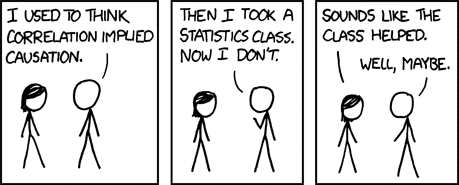
Perhaps the most important thing to note here is that identifying a correlation between microdosing and better mental health does not imply that microdosing has caused a better mental state.
A co-author of the study reiterated that the purpose of the study was not to establish causality, noting that it would not be possible via an observational approach.
***
Placebo and Expectancy Effects; Competing Interests
As pointed out by a number of psychedelics researchers, including Eduardo Schenberg, the words ‘placebo’ or ‘expectancy’ don’t appear once in the paper. This is odd, as we would expect to see the possibility of placebo and/or expectancy effects confounding results discussed.
This isn’t to insinuate that the researchers are consciously seeking to downplay the potential role of placebo and expectancy effects, but rather to highlight the peculiar omission of such a discussion from the write-up.
Others pointed to the lengthy competing interests section at the foot of the paper, which isn’t an uncommon sight in psychedelic research publications these days due to the number of advisory positions many in the space researchers hold.
Paul Stamets, for example, is cited as an applicant on pending patents that cover his ‘stacking’ microdosing protocol, in which psilocybin is combined with various non-psychoactive substances (such as Lion’s Mane mushrooms) in an attempt to increase any benefits associated with microdosing. The protocol is mentioned twenty times in the paper, which reports that over half of the microdosing group were employing this strategy.
***
What Can We Learn?
Having addressed some of the shortcomings of this paper (many of which the authors acknowledge themselves, it should be noted): is there any utility in an observational study like this?
Identifying correlation is often the first step toward justifying further research that attempts to uncover a causal pathway, should it exist. As such, this study contributes to a growing literature covering real-world uses of microdosing protocols, which may encourage and inform more rigorous research endeavours.
As aforementioned, the study also looks at microdosers’ motivations with the most common answers were reducing anxiety and depression, improving wellbeing and enhancing cognitive performance.
“a considerable proportion of those who microdose do so with therapeutic intent to treat mental health symptoms and conditions.”
So, while we can’t identify causality, it is useful to understand the contours of real-world microdosing: who is microdosing, with what intentions, according to what routines, etc.?
***
Further Evidence: Past and Future
A study published earlier this year by Szigeti et al. (2021) – which the study under discussion curiously failed to cite – used an intriguing approach that the team dubbed “self-blinding citizen science.”
Participants in the trial, which was the largest placebo-controlled (though, some may argue that the placebo control is not rigorous in this self-blinding approach, as participants can break the blind) trial of psychedelics to date (n=191), were given online instructions on how to add a placebo control to their microdosing routine.
The researchers found that the psychological outcomes of all participants improved significantly from baseline to week 4. But, crucially, no significant difference was found between microdose and placebo. Researchers thus concluded that their “findings suggest that anecdotal benefits of microdosing can be explained by the placebo effect.”
Read more about this paper, and the potential risks associated with the chronic administration of 5-HT2B agonists, in our March 5th, 2021 Bulletin.
While some may have qualms with Szigeti et al.’s pragmatic self-blinding methodology, it appears that a truly double-blind, placebo-controlled study of microdosing is set to publish soon. Enzo Tagliazucchi, based at University of Buenos Aires, announced on Twitter that his team has “just finished” such a study which sought to measure “objective effects, creativity, perception, actigraphy and EEG.” Tagliazucchi said that “results are, for the most part, negative.”
It is important to note, however, that the participants in this yet-to-be published study (preprint expected next week) were all healthy individuals. As such, some may argue that the likelihood of seeing an improvement in wellbeing is lower, due to a relatively high baseline. Perhaps we shouldn’t write-off the possibility that microdosing may be beneficial to those diagnosis with depression or anxiety, for example.
Elsewhere, MindMed is sponsoring trials of LSD microdosing, including via its recently announced study of low-dose LSD effects on sleep and cognitive measures. The study will be conducted by Dr. Kim Kuypers of Maastricht University, a co-author of the study under discussion.
–
* Note that the paper was published in Scientific Reports, a lower-tier journal within the Nature portfolio. Some reported that the paper was published in Nature, which is misleading.
Other Announcements & News
🏛️ Numinus Set to Uplist to Toronto Stock Exchange | Vancouver-based Numinus has received conditional approval to graduate from the TSX Venture Exchange (TSXV) to the Toronto Stock Exchange (TSX). Shares will continue to trade under the symbol NUMI.
📜 COMPASS Granted 5th US Patent | COMPASS Pathways has been granted its fifth US patent, which is its 10th patent overall. The new patent covers methods of treating treatment-resistant depression with crystalline psilocybin, as well as with oral dosage forms of crystalline psilocybin with an excipient. The company’s synthesised psilocybin formulation, which is used in its trials and dubbed COMP360, contains crystalline psilocybin.
🏥 Cybin Makes Grant to Establish Psychedelic Treatment Clinic | Cybin annoucned that it has awarded a grant for a psychedelic treatment clinic at Lenox Hill Hospital “to serve marginalized and underserved communities on the Upper East Side of Manhattan, New York.”
And the rest…
- Entheon Biomedical provides update on clinical and preclinical DMT programs;
- HAVN Life successfully exports psilocybin from Jamaica facility into Canada;
- Numinus to host Q4 and 2021 annual results call December 9; announces departure of Stacey Wallin;
- PharmaTher applies for FDA Orphan Drug Designation for ketamine to treat Status Epilepticus.
Read more on our News page.
Weekend Reading
Bufo alvarius: A Misguided Grail in the Psychedelic Pharmacopeia
By Robert A. Villa, Tucson AZ.
President, Tucson Herpetological Society – Research Associate, The Desert Laboratory, University of Arizona
Editor’s Note
It seems that each week another celebrity is coming out of the psychedelics closet, so to speak. Appearing at Microdose’s Wonderland conference in Miami, former professional boxer Mike Tyson sung the praises of ‘toad venom.’
Tyson claimed to have “tripped toad” over fifty times, sometimes three times in one day. And, he’s not the first public figure to have publicly shared experiences with toad-derived 5-MeO-DMT. Hunter Biden and Christina Haack are among a number of prominent names to have discussed the experience, for example.
While some may admire these celebrities leveraging their public platforms to destigmatize the use of psychedelics, others might express concern around the use of toad-derived 5-MeO-DMT and the potential cultural and ecological damage that could cause; especially if many other individuals now seek out these elusive secretions.
Folks like Hamilton Morris and Robert A. Villa have been loudly calling for people to Leave Toads Alone, suggesting that synthetic 5-MeO-DMT is a more ethical option.
In this bumper edition of our weekly Bulletin, we’re pleased to publish the below op-ed from Robert A. Villa himself.
Note: As an op-ed, the opinions expressed in this piece are those of Robert A. Villa.
What do we do about our serious existential issues on this planet? It seems our collective, stoned-ape minds have once again renaissanced on the mind-altering molecules ensconced in the world around us. And how far we’ve come…
In a rapidly changing world, I and a handful of colleagues have come to elucidate the plight of a toad, exploited for its ability to produce a “God Molecule” called 5-MeO-DMT. When inhaled, this invisible substance can completely disrupt and overtake the senses, sending one out of consensus reality and inducing oceanic feelings of love, unity, and enlightenment. It is famously known for causing a loss or diminishment of the ego.
Enter Incilius (or, Bufo) alvarius: The Sonoran Desert Toad (Colorado River Toad). When one scholar errs, another alights on discovery. Ken Nelson read an article in Omni magazine which incorrectly associated a pile of toad remains at an archaeological site as artifacts of psychedelic magic (Editor’s Note: click here to view the article from August 1981’s edition of Omni). This is because all toads produce a psychedelic known as bufotoxin. While the remains were later substantiated as food refuse, Ken began a scholarly sleuth that led him to the work of toad chemist Vittorio Erspamer and colleagues.
It appears that they first published on the significance of serotonin in neuroscience (Editor’s Note: see Whitaker-Azmita, 1999, for more on Erspamer’s work), as well as the mysterious occurrence of 5-MeO-DMT solely in the skin secretions of the Sonoran Desert Toad.
So, Ken drove to Arizona, found a Sonoran Desert Toad, extracted this molecule by squeezing the stuff in its skin glands onto his windshield, and seemingly became the first person to inhale the 5-MeO-DMT in the smoke from the dried secretions of this toad.
He was so moved by his experience that he compelled to produce a pamphlet of unusual erudition, graced with the art of his friend Gayle Patterson. He wanted everyone to experience the “toad of light”. He could perceive how a toad could be sent off the map with this new Pandora’s Box. So, he prefaced his instructions with Aesop’s fable of the goose that laid golden eggs. He had no idea how this underground, fringe activity would resurface in an exponentially complicated world.
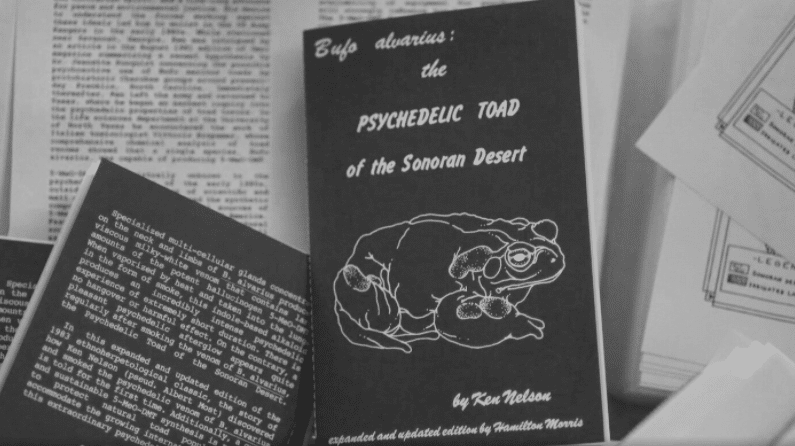
Many of the most important and promising psychedelics have been stewarded by aboriginal peoples across the globe. Centuries of elaboration and practice has provided humans with the most sophisticated therapies found in species and landscapes in imminent danger of extinction.
Psychedelics hold important potential for helping people through some of the most difficult personal problems they face. Most notably things like substance abuse, resistant depression, PTSD, and terminal illness.
These are side effects of dominant, “advanced” societies and cultures impaired (by the exponential rise of extractive capitalism) from experiencing true connection to, meaning and love from, and conservation of the only Earth we have.
No wonder the global north seeks to exploit a perceived silver bullet in the traditional therapies of the global south. Neo-shamanic practitioners abound, espousing existential disruptions for those in search of peace at the monetization of ancient motifs and customs. Speculative anthropology, if you will.
When smoking the secretions of the Sonoran Desert Toad arrived in Mexico, a small vanguard of practitioners began their proselytization to substance addicts, often in conjunction with iboga of western Africa. The grounds were and still are experimental, even in the best possible settings. It is within this fog that the narrative of the Sonoran Desert Toad as an ancient medicine was created within a new age pharmacopeia.
Many have been harmed by these practices as have appeared to benefit. Deaths and serious psychological damage associated with this substance are growing with its popularity. To be clear, it is not the molecule or the substance that warrants blame, but the administrators. Even those who may have the best of intentions are just as susceptible, if not more so, to the potency of the therapies they espouse with deep conviction. See Ethical Considerations below.
As celebrities advertise and advocate their new found glory, they fuel black markets that disrupt meaningful understanding of otherwise promising therapies, and create socio-economic problems in the global south. In the case of the Sonoran Desert Toad, those problems have landed in complex ways for marginalized communities in general, and the Comca’ac (Seri) in particular.
As the Sonoran Desert Toad psychedelic market continues to grow at any cost, our best conceptualizations of sustainability and contingency models are warped by the extractive nature of the market. Michael Crichton would have fertile ground examining the problematic notions and ethics of breeding programs and ecological models in context of a new age pharmacopeia.
We never seem learn that the solutions we most readily gravitate to are warped by the problems that caused them and therefore the most ethically problematic. Something flaunting ostensibly self-actualizing psychonauts.
So, beyond this insidious mania: What does it mean to ask complicated, difficult questions for the benefit of all involved? What does it mean to do no harm? What is the self-made scaffolding we navigate the constructs of our complicated lives with? What do we do with/about it? Who is listened to, and what follows?
For the Sonoran Desert Toad, what does it mean to “Leave Toads Alone”? This is one of the mottos of a media and merchandise campaign we’ve begun to raise funds for beginning to understand the actual status of toad populations in order to afford it relative protections under various governments and agencies (themselves often handicapped by their own rubrics). We are fighting against the juggernaut imposed by biology, ecology, science, celebrity, and extractive exploitable markets as the Earth roars into the 21st century.
Ethical Considerations
Why do you seek 5-Meo-DMT?
- Is it really necessary for your personal emergency or development? What other substances exist within long-established therapies and frameworks for your issue? Prepare yourself for the hard work of understanding yourself and developing yourself after your experience. Seek qualified assistance.
- One must truly understand their body and emotional health to take this powerful tool.
- Do you have underlying conditions that you may or may not be aware of?
- How is your practitioner qualified? What are their guiding frameworks and practices of administration and reintegration into consensus reality?
- Therapists and scientists typically recommend collaborating with two therapists to realize significant benefits.
- In indigenous circles, therapy is typically based on strong community and practitioner relationships within indigenous concepts of reciprocity and appreciation for the network of life we call Earth.
Use laboratory produced 5-MeO-DMT
- The molecules from the lab and the toad are identical and act identically on the brain.
- Qualitative differences between lab and toad-sourced 5-MeO-DMT are hard to qualify because of this. It is inherently a subjective assessment based on what the user brings to the experience.
The toad offers this substance as a defensive measure against enemies, but is exploited for it.
- What does this mean for personal and societal ethical development?
- Collecting large quantities of toads creates a toad vacuum that will eventually exhaust toad populations.
- A perception or fallacy of abundance has already led to the elimination of toads in certain areas as evidenced by a second-hand anecdote of two tons of toads being confiscated in Sonora in the early 2000s.
- While toads are usually not killed during collection and extraction of their secretions (not technically “venom”), they may be physically hurt and typically displaced from their home territories, accelerating death (~20% survival).
- Attempting to maintain or restore wild populations with captive bred toads resonates with a number of problems reflected in similar programs around the world:
- creates subsidized toad predators that will collapse when the program ceases to operate;
- potentially vector existing and new diseases via toads and humans.
- While they almost never succumb to the deadly amphibian disease called chytrid, they could become serious vectors (spreaders) of it as more toads are trafficked, or bred in a captive program scenario; not to mention potential new cross-species diseases to humans.
- It is almost impossible to quantify or document the black market for the Sonoran Desert Toad, making conservation measures difficult.
Donations to conservation research can be made to the Sonoran Desert Toad Fund and shirts and hats supporting this cause can be bought at the Cream Shop.
UK Regulator Publishes First Draft Update to Depression Guidelines in Over a Decade
On Tuesday, the National Institute for Health and Care Excellence (NICE) – which provides guidance and advice for healthcare in the UK – published the first update to its guidelines on depression since 2009.
Under the draft guidance, NICE recommends that a “menu of treatment options” be offered to patients by healthcare professionals before medications such as antidepressants are considered in cases of ‘less severe’ depression.
Under these changes, Brits with mild depression might be offered group CBT as a first treatment. If unsuccessful, they may then be offered: individual CBT; self help; group exercise; group mindfulness; group meditation; etc.
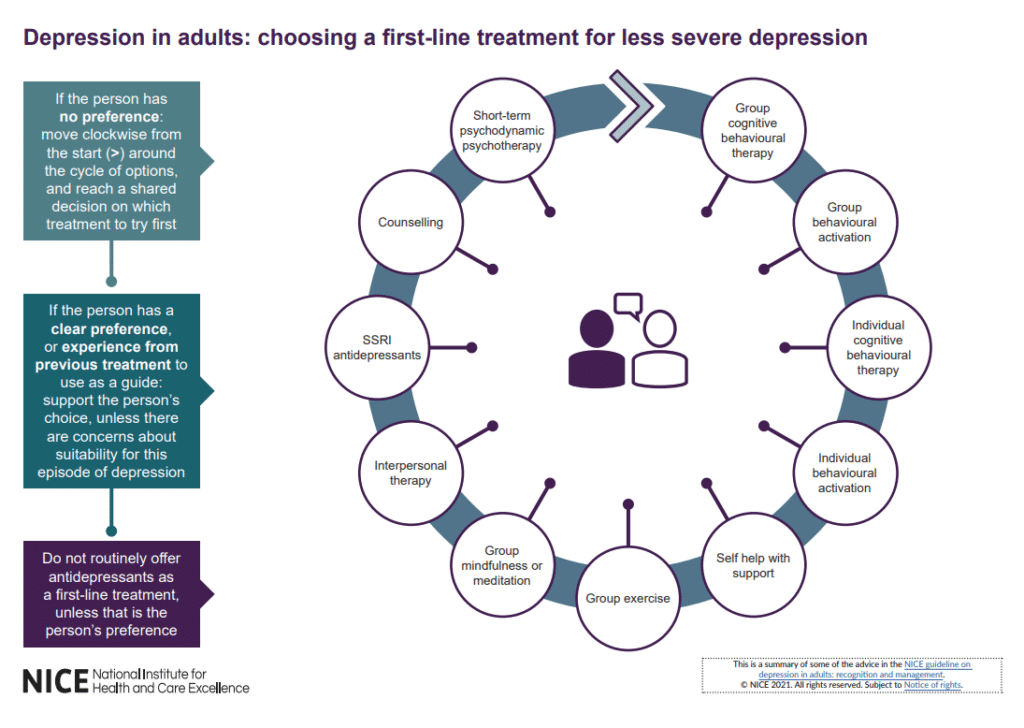
However, as Simon Tankel, CEO of Heading Health, notes, this draft guideline isn’t necessarily a paradigm shift. Rather, it “depicts the current paradigm in psychiatry,” explains Tankel, which is “highly dependent on non-pharmacological interventions and the only pharmacological agents available are traditional antidepressants.”
When we shared the breaking news of these latest guidelines on Twitter, we were inundated with reactions from those with first-hand experience attempting to access mental health services via the UK’s National Health Service (NHS). One of the most common reactions questioned where the funding for these non-pharmacological interventions might come from, given the fact that current waitlists for CBT in the UK are in the order of months.
Former GOP Texas Governor Rick Perry Supports Psychedelic-Assisted Therapies for Veterans
Former GOP Texas Governor Rick Perry appeared on stage alongside Tim Ferriss and Rick Doblin at a gala in support of Veterans Exploring treatment Solutions (VETS), a non-profit dedicated to assist U.S. veterans seeking psychedelic-assisted therapies.
Huge thanks to VETS (@vetsforvets) for having me at the Strength in Numbers Gala to End Veteran Suicide on 11/11.
— Tim Ferriss (@tferriss) November 15, 2021
(1/3) 👇 pic.twitter.com/nzfyTFHmH4
Odds and Ends
🥼 INVERSE: Magic Mushroom Study Suggests Psilocybin May Reverse Alcohol-Induced Brain Damage. In this excellent write-up of a recent publication, Inverse’s Katie MacBride looks at how new research pinpoints a specific glutamate receptor in brain cells that’s affected by alcohol use. Interestingly, when mice that were used to mimic alcohol use disorder were treated with psilocybin, researchers observed that their glutamate receptor function appeared to repair. Fierce Biotech also covered this research.
🎧 Podcast: The Behavioural Investor: S3 E6 🍄 The Science, Taboo and Business of Psychedelics with Tara Austin and Josh Hardman. Psilocybin Alpha’s Josh Hardman appeared alongside Tara Austin on the latest episode of The Behavioral Investor podcast. “In this episode we introduce you to the science, taboo and business of psychedelics.”
Weekly Bulletins
Join our newsletter to have our Weekly Bulletin delivered to your inbox every Friday evening. We summarise the week’s most important developments and share our Weekend Reading suggestions.
Live Updates
Join us on Twitter for the latest news and analysis.
Other Channels
You can also find us on LinkedIn, Instragram, and Facebook.

